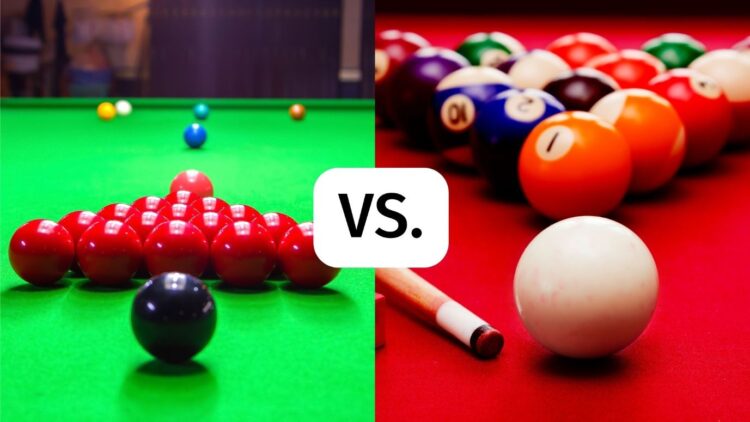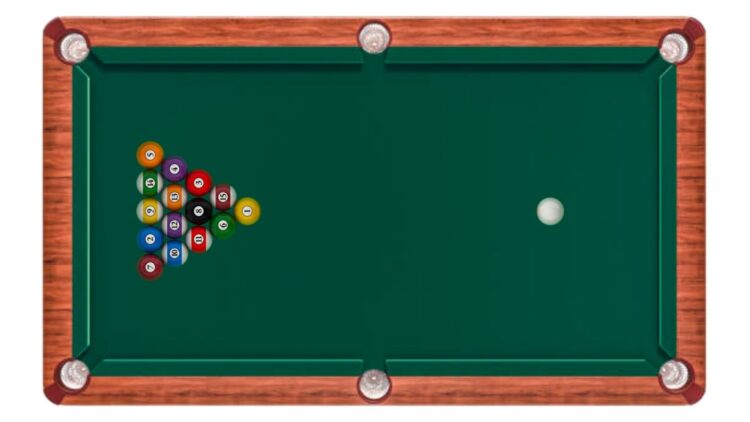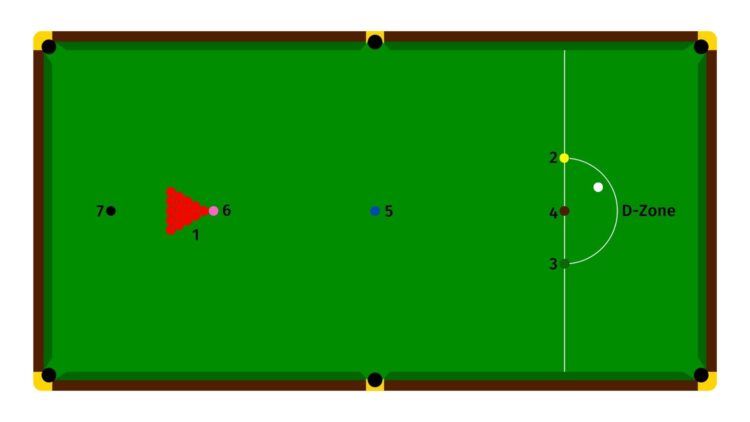
Pool and snooker are two similar cue sports that frequently get confused with one another. To make matters even more confusing, all of these sports are considered billiards sports, even though “billiards” is also its own game. These sports are played in a similar way, but they have some key differences.
In this article, we will dive into the many similarities and differences between pool and snooker.
SIMILARITIES

Before discussing the stark difference between billiards pool and snooker, it is important to first address their similarities:
1) Both are played on a pocket billiards table
Pool and snooker are both categorized as “billiards sports” because they’re played on billiards tables—flat rectangular tables covered in cloth and surrounded by rubber bumpers. Unlike the actual game of billiards, however, pool and snooker are played on tables with six pockets.
But keep in mind, as you’ll soon find out, these tables are not identical to each other.
2) Both involve using a cue to hit a cue ball
Like all cue sports, pool and snooker involve players using a wooden cue stick to hit a white “cue ball”. The cue stick can only contact the cue ball, meaning the only way to score points is by knocking the cue ball into the other balls on the table.
3) Both utilize a “make it, take it” rule
In both pool and snooker, a player’s turn only ends when they can’t successfully “pot” (hit into a pocket) a ball or commit a foul. This means a round of pool or snooker could end with one player not even getting a chance to play.
4) Both games end when the black ball is potted
Pool and snooker matches end when one player hits the black ball into a pocket when it is the last remaining ball on the table.
DIFFERENCES
It is important to note that the game of pool has many different versions and ways to play. For the sake of simplicity, the game of eight-ball pool, which is the most popular recreational version of the sport, will be the version being compared to snooker.
EQUIPMENT
- Playing Table: Snooker tables are always larger than pool tables, although the exact sizes of these tables differ between countries (specifically the US and UK). Snooker tables tend to be around 10-12 feet long, and pool tables tend to be 8 feet for recreational use and 9 feet for a tournament table. Snooker tables also have smaller pockets and use a cloth surface that is fuzzier than pool tables.
- Cue Stick: Both sports use cue sticks measuring 57–58 inches in length. Snooker cue tips are much smaller (9.5 mm) than pool cue tips (13 mm).
- Balls: Pool uses 16 balls, while snooker uses 22. Pool uses one white cue ball and 15 numbered balls (1–7 are striped, 8 is solid black, and 9–15 are solid colors). Snooker uses one white cue ball, fifteen red balls, and six colored balls (one blue, brown, green, yellow, black, and pink).
TABLE SET UP
POOL table

All 15 colored balls are “racked” near one end of the billiard table in a triangle shape, the tip of which points to the center of the table. All the balls are placed randomly in this rack, although the black eight ball should be near the center, and the two corners of the triangle’s base should have a striped ball on one side and a solid color ball on the other.
The white ball can be placed anywhere behind the “head string” line on the opposite end of the table.
SNOOKER table

All 15 red balls are racked at one end of the table in a way similar to pool. The six colored balls are then placed in very specific places:
- The black ball is placed behind the triangle of red balls and is the closest to the end of the table.
- The pink ball sits closer to the center of the table, directly at the tip of the red ball rack.
- The blue ball lies precisely in the middle of the table.
- The green, orange, and yellow balls are placed on a line at the end of the table opposite the other balls. This is roughly the same “head string” line used in pool.
Behind the white line on which the green, orange, and yellow balls sit is a small semicircle or “D” intersecting. This area within this “D” shape is where the white cue ball must be placed.
GAMEPLAY
Both snooker and pool matches begin with one player hitting the cue ball into the rack of balls on the opposite end of the table.
POOL
The goal of the player who starts first is to disrupt the entire rack and pot one of the striped or solid balls in the process. If successful, this means the starting player can keep playing until they fail to pot a ball or commit a foul.
The first ball type a player sinks (striped or solid) is the one they’re tasked with potting the rest of the match. This means one player targets the striped balls while the other player targets the solid-colored balls.
The objective of eight-ball pool is for a player to pot all seven of their respective balls (striped or solid) and then lastly pot the eight ball to win.
SNOOKER
The goal of the starting player when breaking the rack is to disrupt the red balls while subsequently getting the cue ball into a challenging position for their opponent to start. Therefore, it is rare for the opening player to sink one of the red balls, although they’re able to keep playing if they manage to do so.
For the rest of the match, each player must sink a red ball and then sink any colored ball of their choice. Once a red ball is potted, it remains out of the game. Colored balls are placed back on the table in their starting position when potted with red balls.
Once all red balls are off the table, the remaining six colored balls must be potted in ascending order corresponding with their point values. This would mean both players must pot yellow, then green, brown, blue, pink, and finally black, in that exact order.
Once the final black ball is sunk, the game ends. Unlike pool, however, the player who sinks the black ball does not necessarily win the game (see: SCORING).
SCORING
POOL
Pool does not use a scoring system. Instead, whichever player is first to successfully pot all of their balls, and the final black ball wins the match.
SNOOKER
Snooker uses a points system to determine the winner of each frame (match). Each ball is worth a specific number of points:
- Red = 1 point
- Yellow = 2 points
- Green = 3 points
- Brown = 4 points
- Blue = 5 points
- Pink = 6 points
- Black = 7 points
This means that, in order to score the most points possible, a player would ideally aim to sink the black ball after each red ball they pot.
The player who scores the most points is the winner of the frame, not the player who sinks the final black ball.
RULES
Both snooker and pool share a couple of general rules:
- The white cue ball cannot be potted
- All balls must stay on the table
- Failing to pot a ball or committing a foul results in a loss of turn
- The cue stick cannot contact any ball other than the cue ball
Apart from these, each sport holds its own specific rules:
POOL
- The black ball cannot be potted unless it is the final ball; potting the black ball early results in an automatic loss for the offending player.
- The opening rack break must either pot a ball or disrupt the rack enough so that four balls hit the sides of the table.
Pool fouls, other than illegally potting the black ball, simply result in a loss of turn.
SNOOKER Balls
- When you play snooker all balls must stay on the table at all times; a player cannot use a “jump shot” to hit the cue ball over another ball (as is legal in pool).
- Balls must be potted in the correct order; each time a red is potted, a colored ball must be potted. The final six balls must also be potted in accordance with their point values (low to high).
- The cue ball must always hit the intended ball before touching any other balls (cue ball can’t first hit a colored ball on a shot intended for a red ball).
Snooker fouls result in a player losing their turn and any points gained from the shot that resulted in the foul.
POPULARITY
Pool, specifically eight-ball pool, is the world’s most popular billiards game and is the most prevalent in the United States. There are also many pool games that have formed outside of the main sport.
Snooker, meanwhile, is incredibly popular in the United Kingdom, although it’s unknown in many other parts of the world.
OVERALL COMPARISON
Like all billiards sports, billiards pool and snooker require extremely similar skill sets. That said, the differences in table size, pocket size, rules, and the number of balls that need to be potted can make each sport feel quite different.
Straight pool, being the much more straightforward of the two games, only requires each player to pot their specific ball type before sinking the final black eight ball. However, snooker uses balls worth different points, determining a winner based on their overall score.
So, while both sports share the same common objective of potting coloured balls into pockets, they mainly differ based on the order in which these balls need to be potted and the ways in which a winner is determined.
- 20+ FREE PRINTABLE BABY SHOWER GAMES - April 16, 2024
- 20+ College Party Games for the Best Night Ever! - April 2, 2024
- 31 BEST MOVIE DRINKING GAMES - March 14, 2024